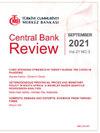Impact of the Syrian refugee influx on Turkish native workers: An ethnic enclave approach
Abstract
Turkey received about 2.7 million Syrian refugees between 2011 and 2015. This paper examines the causal impact of this influx on the Turkish natives' labor market outcomes using the micro level annual Household Labor Force Surveys. The migration impact is analyzed in two distinct categories considering the motives behind the migration decision. The initial migration to the border regions is defined as the primary migration and a standard difference in differences strategy is employed to estimate the labor market impacts in those regions since the initial flow to the border regions was completely exogenous. The migration from the primary regions towards the inner regions, on the other hand, is subject to endogenous selection. Hence, I defined it as the secondary migration and developed an instrumental variables estimation method to address the selection bias following the Card (2009)'s ethnic enclave approach. I found statistically significant negative employment and wage effects on the low-skilled and less-experienced individuals in the primary migration analysis. The decline in the wages of informal workers is the main contributor of the negative wage effects. Secondary migration has no impact on the employment but there are statistically significant negative wage effects on the low-skilled and less-experienced workers.

 求助内容:
求助内容: 应助结果提醒方式:
应助结果提醒方式:


